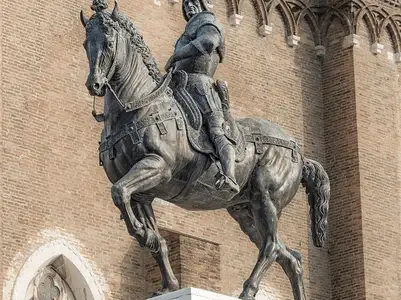Title of Artwork: “Equestrian statue of Bartolomeo Colleoni”

Artwork by Andrea del Verrocchio
Year Created 1480 – 1488
Summary of Equestrian statue of Bartolomeo Colleoni
In Campo Santi Giovanni e Paolo, Venice, Italy, you may see Andrea del Verrocchio’s Equestrian statue of Bartolomeo Colleoni (created between 1480 and 88). Excluding the pedestal, the statue of condottiero Bartolomeo Colleoni (who served for a long time under the Republic of Venice) stands at 395 cm tall.
After Donatello’s Gattamelata statue, which also features a rider on a horse, this is the most famous equestrian sculpture to come out of Italy during the Renaissance (1453).
All About Equestrian statue of Bartolomeo Colleoni
Condottiero Colleoni, a former Captain General of the Republic of Venice, passed away in 1475 and donated a sizeable portion of his estate to the Republic of Venice on the condition that a statue of himself be commissioned and installed in the Piazza San Marco.
The Republic proclaimed its acceptance of the gift in 1479, saying that the statue would be displayed at the plaza in front of the Scuola of San Marco because sculptures were forbidden in the Piazza. A sculptor was chosen through an open competition.
There were three sculptors vying for the commission: Verrocchio of Florence, Alessandro Leopardi of Venice, and Bartolomeo Vellano of Padua. Verrocchio’s model was constructed of wood, while the others’ were made of wax and terracotta. Verrocchio was given the commission after seeing an exhibition of the three models in Venice in 1483.
Next, he set up shop in Venice, where he created the final wax model that was eventually ready to be cast in bronze. However, he passed away in 1488, before the casting could be completed.
Although he had originally requested that his student Lorenzo di Credi—who was in charge of his Florence workshop at the time—complete the statue, the Venetian state ultimately commissioned Alessandro Leopardi to do so, and Leopardi also created the pedestal upon which the statue now rests in the Campo SS. Giovanni e Paolo.
The sculpture was inspired by a number of works, including Donatello’s statue of Gattamelata, the St. Mark’s Horses in Venice, the Regisole (a late antiquity work in Pavia, now lost), the Funerary Monument to Sir John Hawkwood by Paolo Uccello, and the Equestrian Monument to Niccol da Tolentino by Andrea del Castagno.
The primary challenge he faced was one of statics: if he were to depict the horse in motion with a raised leg, the bronze would topple over from the weight of its own momentum, as it would be supported by only three rather thin legs.
Donatello had found a partial solution to this in his monument at Padua by resting the lifted leg on a sphere. In the beginning, Verrocchio was the one who figured out how to make a horse stand on three legs.
Art historian Passavent praised how great it looks in its current location, noting that “the magnificent sense of movement in this figure is shown to superb advantage in its present setting” and that as sculpture “it far surpasses anything the century had yet aspired to or thought possible.”
This is despite the fact that it was not placed where Colleoni had intended. He argues that the human and the horse are both excellent in their own right and that they form an integral element of the sculpture as a whole.
Information Citations:
En.wikipedia.org, https://en.wikipedia.org/.
























